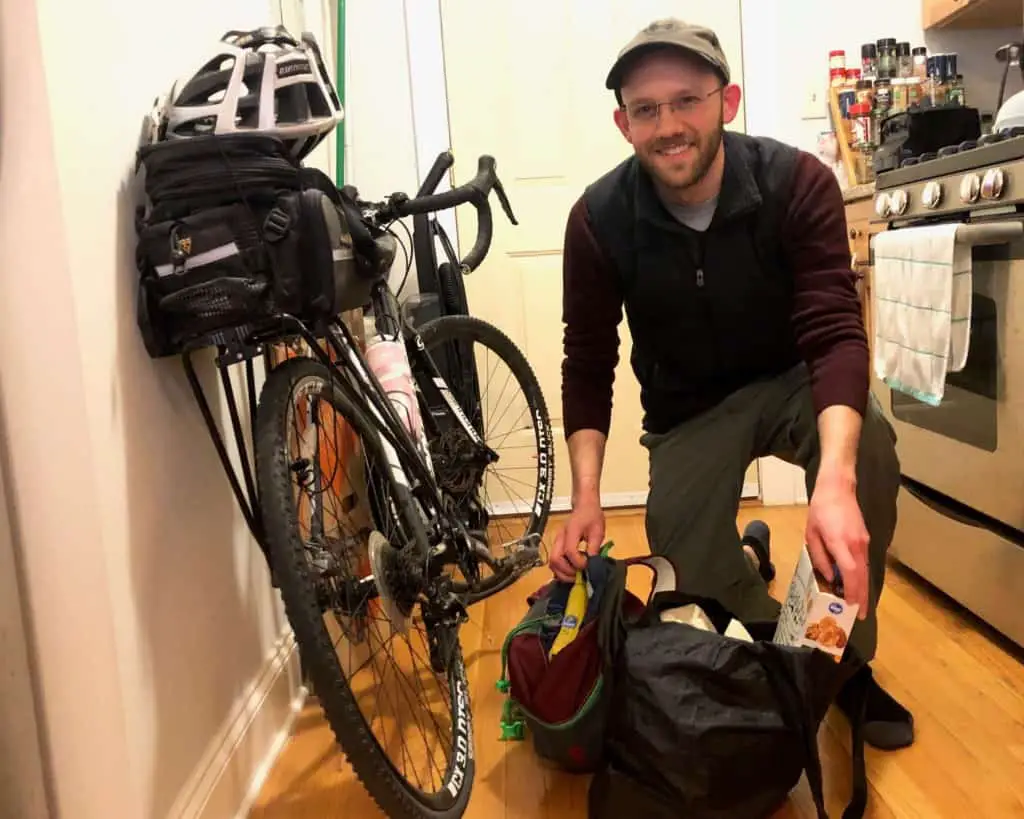
If you don’t have a car, or if you recently moved to a big city, then you might be wondering how you can get groceries without a car.
There are 6 main approaches to getting groceries when you don’t have a car: on foot, by bicycle, on the bus or train, with Uber or Lyft, getting groceries delivered, or using a carpool or renting a vehicle.
Back when this post was first written, getting groceries delivered wasn’t as common as it is now. But, that’s not the only way to get groceries without a car. The best approach for you will depend on your specific situation, like your location, physical health, budget, etc.
All of these options can work well, and in each section below we’ll cover who that approach works best for, and some tips for how to make it work. Let’s dive in!
Disclaimer: This post contains affiliate links. This means I may earn a commission should you choose to make a purchase using my link
Table of Contents
6 Ways to Get Groceries Without a Car
1. Walking to The Grocery Store
Who it works best for:
Fit city-dwellers who live within walking distance of a grocery store.
Making it work:
I carried my groceries home on foot pretty regularly for about 6 years when I lived in a big city, and I hit a stride with my approach to packing and carrying.
My preferred approach was to carry a backpack, and inside my backpack, I carried 2 to 3 reusable bags. Here’s what my setup looked like:
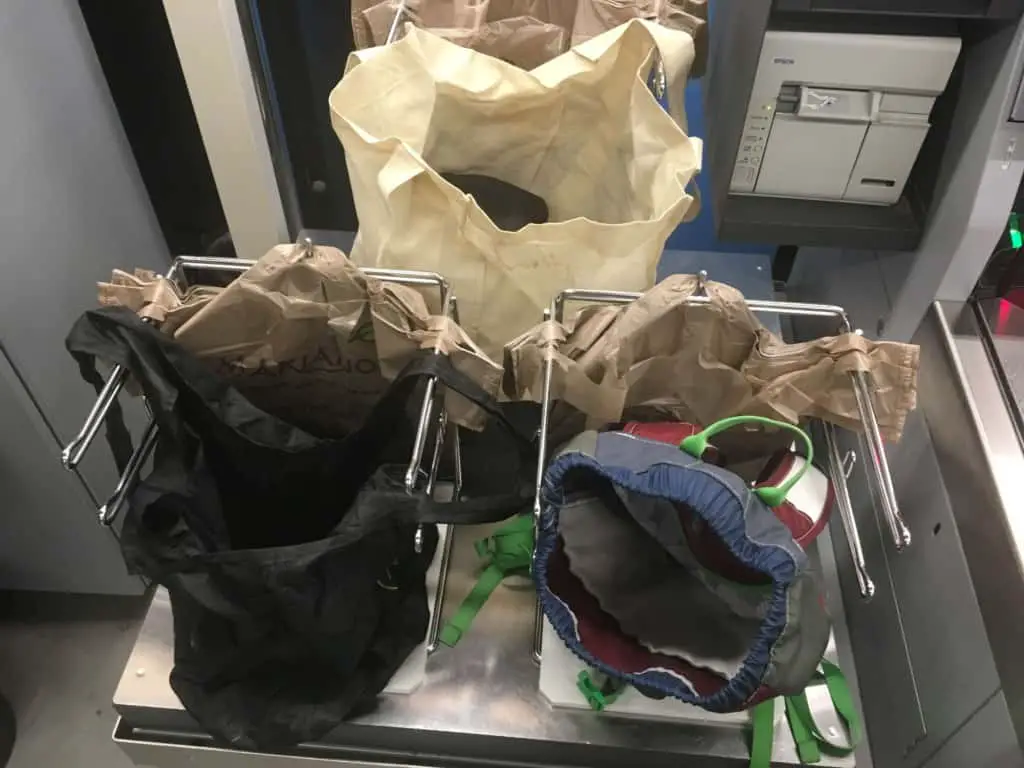
When I pack my groceries at check-out, I stuff my backpack with heavier items like milk, canned goods, potatoes, flour, etc.
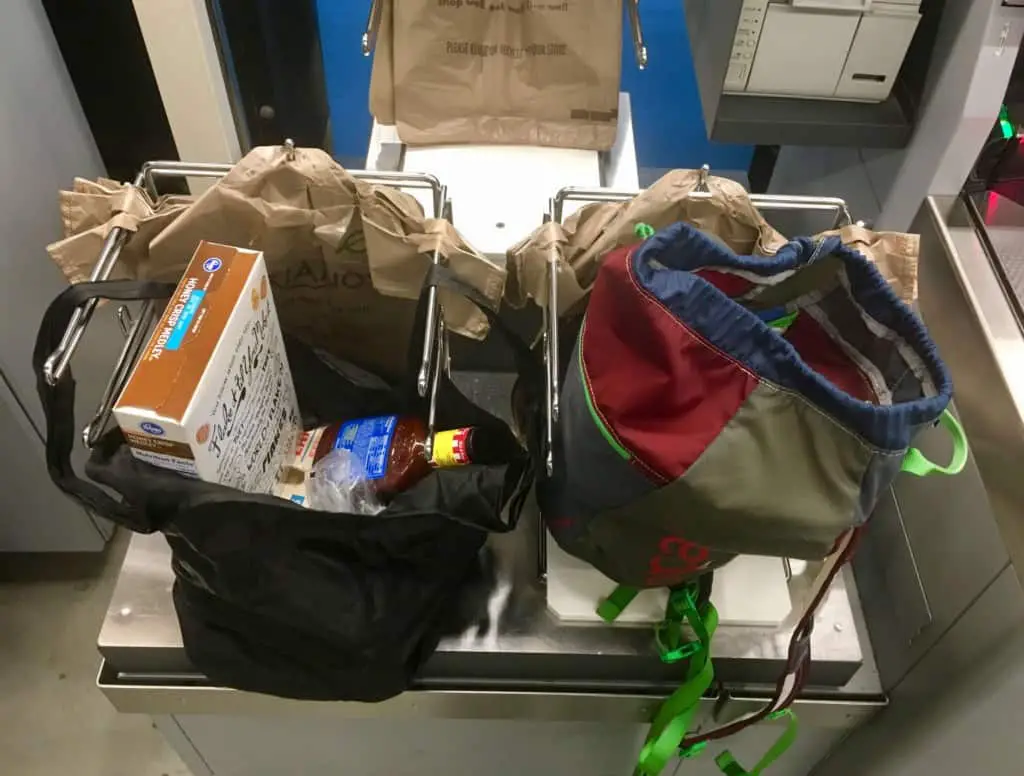
And then I put lighter, or more fragile items, in my tote bags. Examples of this would include eggs, cereal, tortilla chips, etc.
It’s not easy to carry a week’s worth of groceries in one trip, but with this 3 bag approach, I can get pretty darn close. I’d encourage you to give this set-up a shot or try a different bag combo.
One more thing. If you need to move your groceries on foot, but carrying bags like this is tough for you, then consider trying a grocery cart or some kind of rolling bag like the one in the photo.
I haven’t used one of these myself, but I see a lot of people using them, and I’ve been wanting to try it out. It seems like it would work well.
A rolling cart like this would also be a great option if you’re going to a farmers market.
Alright, with that covered, now let’s talk about riding your bike to the store.
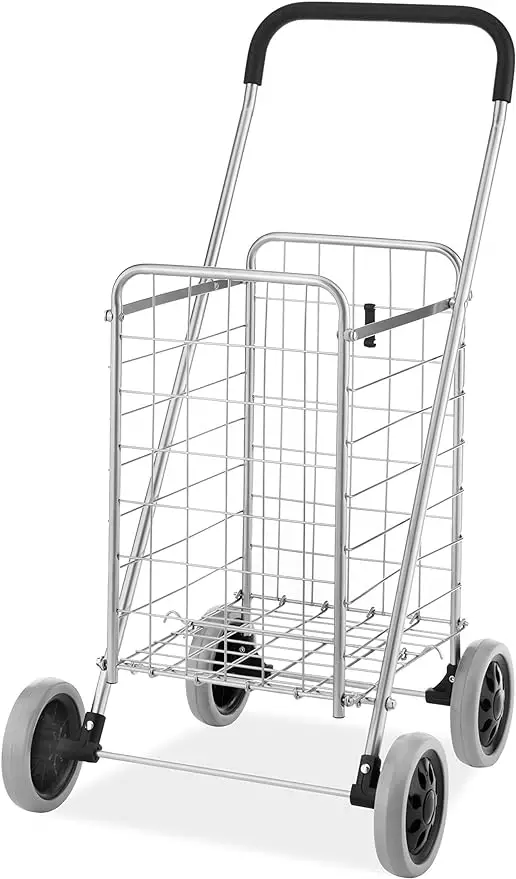
Utility Shopping Cart (this is an affiliate link to Amazon)
2. Getting Groceries on a Bike
Who it works best for:
Able-bodied folks who live within biking distance to the nearest grocery store.
Making it work:
Where you live has a big impact on how easy (or difficult) it is to make your grocery runs on a bike. In addition to the distance of the ride, you’ve got to consider 3 other things before you go with this option:
- Road safety
- Theft
- Grocery bags
Let’s briefly touch on each of these 3 points. First, safety.
Before you decide to use your bike for grocery shopping, you need to ask yourself questions, like: Are the streets busy? Do they have bike lanes? etc. If any of these conditions seem risky, you might want to go with a different option.
Next, unfortunately, bike theft is a very real (and common) problem in a lot of places.
You’re not going to believe this, but I once had someone steal my bike by cutting the lock, and they proceeded to simply re-lock the bike with a new lock in the same location! Crazy.
When thinking about the risk of theft, consider the value of your bike, and the availability of bike racks for locking-up. I really like biking, and I have a somewhat expensive cyclocross bike. I wouldn’t want to leave that bike outside the store. So, for a while I used a beat-up mountain bike for those trips.
Alright, now for the bags. There are five main options for bicycle grocery bags. They all have their own advantages and disadvantages. Here’s the list:
- A trunk rack bag (see below)
- Panniers (e.g. a bag that hangs on the left or right side of your wheels)
- A handlebar bag or basket
- A B.O.B. trailer (e.g. a small trailer that attaches to the back axle)
- A backpack (for your actual back, not the bike)
I have used all of these methods to carry stuff on a bike (yes, even the classic front basket). But my favorite, and the type of bag I have on my bike right now, is the trunk rack bag.
Part of the reason I like this approach is that my trunk rack bag has a central compartment, but it also has two side bags that fold down and provide a lot of extra storage space. Here’s a picture from the side:
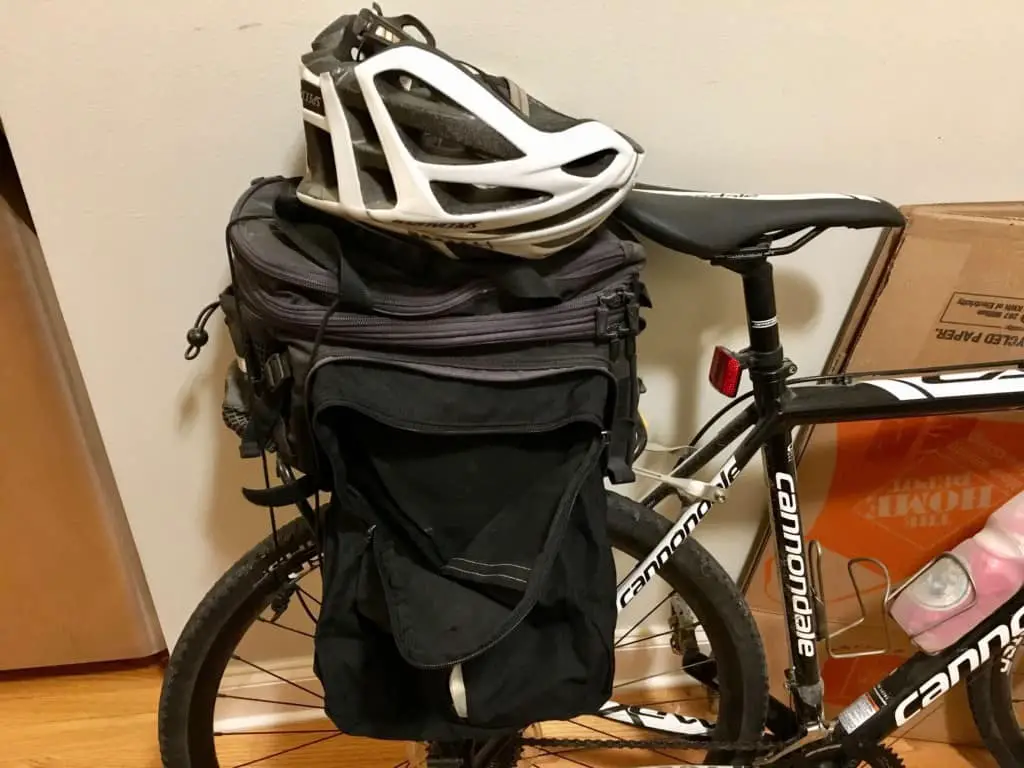
Using a bike is also a great way to get fresh food and fresh fruits from a farmer’s market.
If walking or biking to the grocery store doesn’t work for you, then you may want to figure out how to get groceries on the bus or train. We’ll cover that next.
3. Transporting Groceries on the Bus / Train
Who it works best for:
People who live near a bus or train line, in a city with a reliable public transit system.
Making it work:
I’ve been car-free for nearly 6 years, and as a result, I’ve become very familiar with the local public transportation system.
You can carry groceries onto the bus/train, in the exact same way you would carry it on foot (e.g. using tote bags, a backpack, or cart). But, there are a few additional tips you’ll want to keep in mind to make this process easy on yourself.
First, if you need to make a grocery run and plan to take the bus/train, plan your trip to avoid busy times (e.g. rush hour). It can be really unpleasant to try to find a place for your two big bags of groceries, on a bus/train that’s crowded.
By going during times when public transportation is less busy, you’ll probably also be able to find an extra seat where you can put your groceries down while you ride. As you can imagine, this is WAY more pleasant than having to hold your groceries the whole time.
Second, check to see if there are any grocery stores on the way during your daily commute. If that’s an option for you, then consider making more frequent trips to the store, and only buying a few items each time. This can make things a lot easier, and less strenuous.
If the public transit option doesn’t work for you, or if you just need a break from the crowds, then try using an Uber or Lyft.
4. Getting Groceries with Uber / Lyft
Who it works best for:
People who can afford it, who aren’t able to walk, bike, or take public transit to the store (or for those who just need a break!). This is also a good option for those who need to buy something too large to carry.
Making it work:
This is pretty simple if you have a smartphone. Many people living in large cities/towns already use Uber and Lyft, but if you don’t, you can download the app and summon a local driver to take you where you need to go (kind of like a cab ride, but usually much cheaper).
A couple of tips for using this option: First, consider reducing your costs by using a different method to get to the store (e.g. walk, bike, bus, train). Then use an Uber/Lyft when you have all your groceries on the way back.
Another way to save money using this option is to use the Uber Pool or Lyft Line option in the app. This means that you are willing to carpool with multiple other riders.
The price to use Uber Pool and Lyft Line is often much lower than the full rate for a dedicated Uber or Lyft. Most drivers will have plenty of trunk space where you can stash your groceries, even with multiple riders.
Next up, you can also get your groceries brought straight to your door.
5. Getting Groceries Delivered
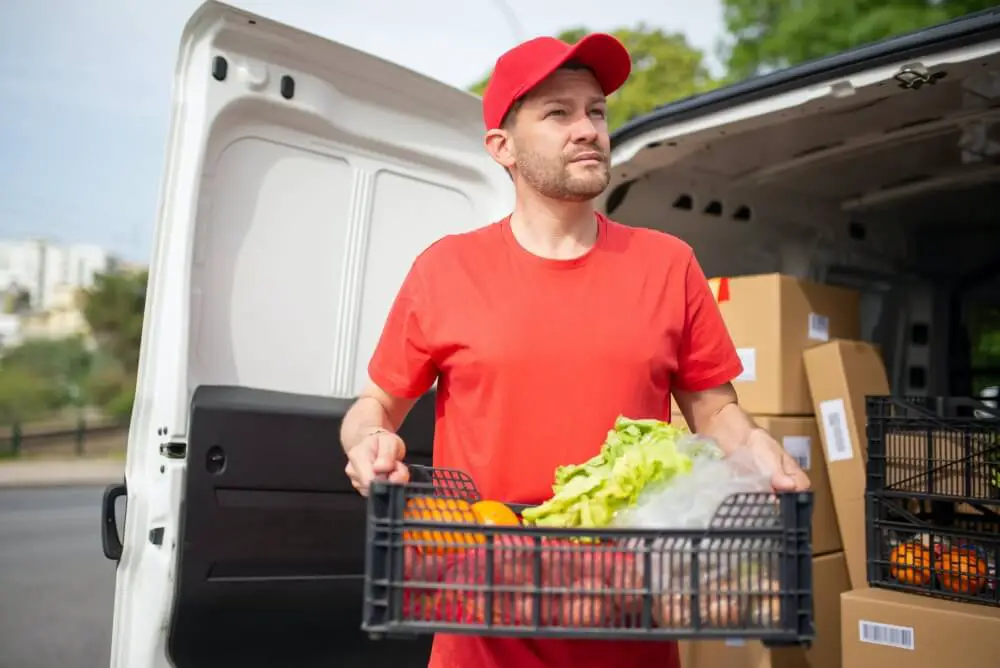
Who it works best for:
People who have difficulty getting around, don’t have time to go to the store, or live far away from the nearest grocery store (but still in range of a delivery service).
Making it work:
Grocery delivery services have evolved pretty dramatically over the last few years, especially since covid made it a necessity. Here are a few of the most well-known food delivery services available today:
- Amazon Prime Now and Amazon Fresh
- Wal-Mart Delivery (or delivery from any local grocery stores)
- Shipt
- Instacart.com
- Peapod.com
- FreshDirect
- Thrive Market
These services have a variety of different packages. Many of them have a $5-10 delivery fee, but some have free shipping if you are a “member” of their program (like Amazon Prime Now), if you pay a monthly subscription (like Instacart), or if you meet a certain minimum order size (like Walmart Delivery).
If it costs you more than $5-10 to get to the store and back, then you might save money by simply having your groceries delivered to your home.
If you were using Ubers to get to the store, then you would probably save money by using home delivery, you might even save money if you were taking the bus or train.
One other thing to keep in mind before you decide to go with home delivery, is that these only operate in certain geographies. Some of the services have wider ranges, but most are limited to a certain proximity of the grocery store.
I’ve lived in big cities, but I’ve also lived outside city limits where groceries are too far to be delivered.
If all else fails, you can carpool, borrow, or rent a car.
6. Using a Carpool or Rental to Get Groceries
Who it works best for:
People who can’t get to the store using any of the other methods mentioned above, or those who can easily carpool or borrow from someone.
Making it work:
If you have a roommate, relative, or neighbor who does have a car, you might be able to go with them when they drive to the grocery store.
That way it’s not adding any (or much) extra driving for them, and maybe you can split the gas costs with them to make it a win/win. I’ve gone on grocery runs with roommates multiple times in the past, and it worked out pretty well for us.
If you don’t have roommates, maybe there’s a nearby neighbor who you could try coordinating with. It might seem like a hard thing to pitch, but if you know them, people often like helping others, and I’d also suggest offering something to them in return (maybe splitting gas, or a small favor, like helping with a house repair or baking them a pie).
If carpooling doesn’t work, then you could also check to see your local rental options. Since trips to the grocery store usually don’t take a full day, it might not be worth it to get a full-day rental from a company like Avis or Hertz.
However, there are also “hourly” car rental services like Zipcar, that you could consider. I think this would probably end up being more expensive than something like a grocery delivery service, and maybe even more expensive than using Uber.
But, it’s something to consider, especially if you have something really big you want to bring home (like a new TV).
Related Questions
Can You Put Holes in Apartment Walls?
You can generally put small holes in your apartment walls, as long as you fix the holes before you move-out. Otherwise, you will likely have to pay for damages or surrender your security deposit. Of course, each lease is different, and you should check your specific requirements to make sure you’re compliant.
Are Landlords or Tenants Responsible for Air Filters?
Renters are usually expected to replace air filters themselves. This includes the purchase of the filters, although many landlords will provide a couple of extra filters as a courtesy. There are some variations, however, and you should check your lease for the specific expectations.
